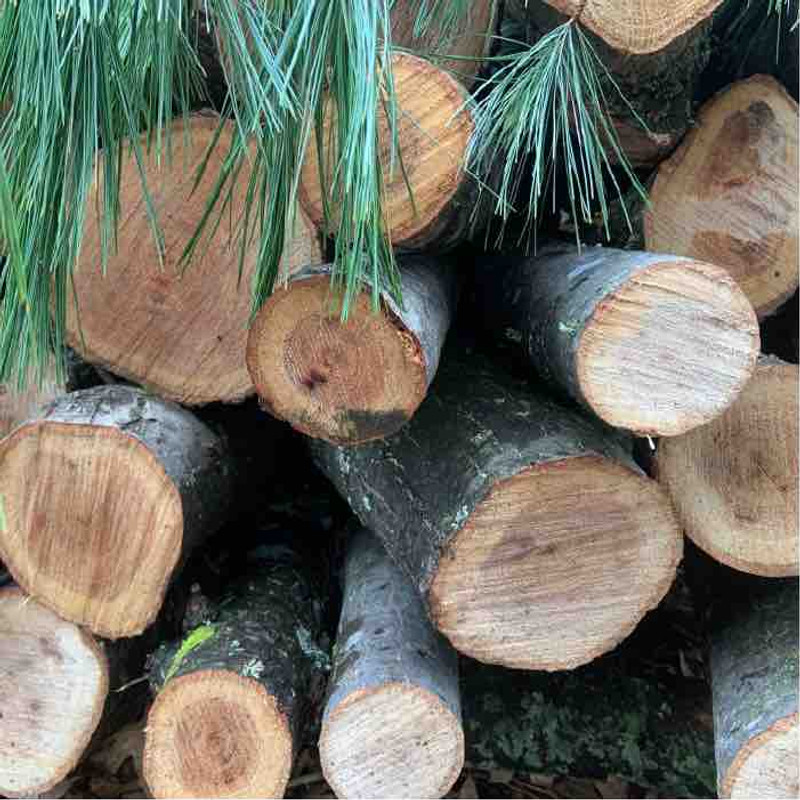Growing mushrooms on logs is one of the most sustainable ways to grow mushrooms, both for your wallet and the environment. There's often a misconception that the harvest of trees is bad for the environment. Most cuts are meant to improve the forest, encouraging the strongest crop trees to grow well by reducing competition while also making allowances for wildlife, watershed protection and long-term sustainability. Whether buying wood from an adjacent county or cutting from your own woodlot, it's important to know where the wood comes from and why it was cut, helping you to judge not only the quality of the wood, but the quality of the forest as a resource.

Sourcing Wood to Grow Mushrooms on Logs
Sourcing the appropriate wood for mushroom cultivation can range from very easy (you own a woodlot) to difficult (you live in an apartment downtown). No matter where you are, suitable logs can be accessed for log-based cultivation, you just need to be resourceful and sometimes accept that fact that you will not be able to acquire "prime" species but rather something that works "good enough". Below we've listed off our top 6 places for sourcing mushroom logs.
1. Your Own Woodlot
The responsibilities of owning a woodlot are many: managing it for productivity in a way that will provide future forest products, providing a haven for wildlife, and ensuring a means of protecting soil and groundwater resources. Management should include a forestry management plan drawn up by a professional forester so that trees are not cut willy- nilly with no provision for the composition and health of the future stand of trees. Good forestry practices will insure that the forest will be sustainable for decades while being managed in an ecologically conscience way while still providing the raw material for log based mushroom production.
If you don't have a woodlot yourself, reach out to your friends or family that do! They're most likely willing to cut a few logs for you for a reasonable price (or a tray of baked goods).
2. Federal, State, County Forests
If you are located near public forested lands, chances are that there is a management plan written on how the forest will be managed and when cutting will happen as part of that management plan. Talk to the area forester and they should be able to direct you towards recent or cuts or approaching timber sales. The tree tops are left behind and though tops can be difficult at times to work through, the payoff is great sapwood to heartwood ratios which make this wood very productive.
3. Indigenous Communities Forests
In the eastern U.S. many Native communities hold vast tracts of commercial woodlands that provide income to the community and are managed following good forestry practices for long term sustainability. We source our logs from these communities as they are nearby and have thousands of acres of prime wood suitable for mushroom cultivation.
4. Private Commercial Forest Lands/ Logging Companies
Throughout the country commercial forest lands are owned privately and harvested for saw logs and pulp. The company doing the logging would be the contact here to see if tops could be sawn for logs. Every region has its local logger and can be a great source for obtaining raw material. Be aware though that larger logging operations often use feller bunchers to automate the harvest of small diameter wood, damaging the bark and rendering it useless for mushroom cultivation.
5. SHIIGA's Woodsource Connection
SHIIGA is an organization that began in the mid 80s when interest in growing Shiitake on logs was in its infancy in the USA. The state of Wisconsin, with its abundant private and public woodlands, was a natural spring board for mushroom growing ideas. The organization remains active in presentation of local workshops in the state but also has a buy/sell platform for mushroom wood. For a $20 annual membership, you can post wood for sale or look to see what is available. The site provides contact information should you see wood in a location near you. The site is meant to be nationwide, and hopefully with some awareness its membership will grow. Be aware that the current postings are quite old, so reach out to the organization via email to see if there are active postings in your area.
6. Local Arborists/Municipal Tree Programs
In urban areas shade trees are often removed due to new construction, landscape regeneration, or due to safety issues. Good urban tree programs often involve periodic pruning of street trees to maintain form and remove hazard branches. This is a source of wood that is available but at times difficult to track down. Contact your local arborist or city forester to see if they have what you are looking for. Bear in mind that you may not be able to score prime sugar maple or white oak logs but remember, fungi are adaptable and you should be too!
For instance, Norway maple will grow shiitake quite well, and birch or ornamental cherries work quite well for nameko. Box Elder and other soft hardwoods such as willow work quite well for oyster mushrooms so if aspen or tulip poplar isn't available substitutions will work out for a backyard effort. The benefit to using urban wood is that it keeps it out of the landfill, particularly the larger diameter pieces which cannot be readily chipped.
Speaking of chipping, another potential source for free wood might be ChipDrop. This nationwide collaborative effort between homeowners and arborists supplies wood chips to homeowners, but they also have a function to deliver logs. However, ChipDrop isn't particular about tree species type, so make sure to be around to ask the arborist what you're getting!

